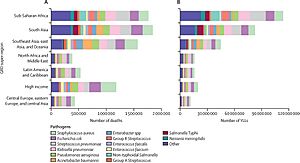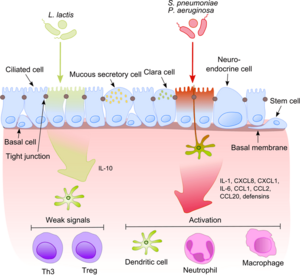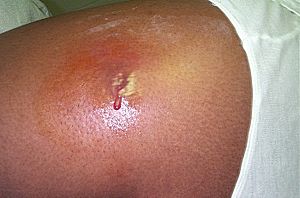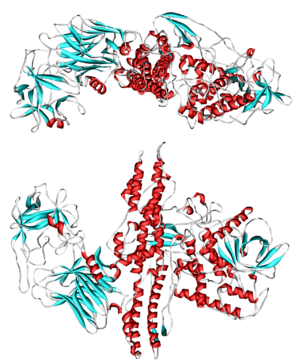Pathogenic bacteria facts for kids
Quick facts for kids Pathogenic bacteria |
|
|---|---|
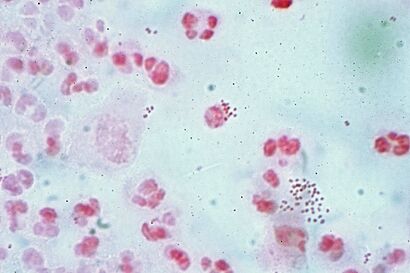 |
|
| Neisseria gonorrhoeae (small red dots) in pus from a man with a urethral discharge (Gram stain) | |
| Frequency | Lua error in Module:PrevalenceData at line 4: attempt to index field 'wikibase' (a nil value). |
Pathogenic bacteria are tiny living things called bacteria that can make people sick. This article talks about the bacteria that cause diseases in humans. Most types of bacteria are actually harmless. Many are even helpful, like the ones in your gut that help you digest food. But a small number of bacteria can cause infectious diseases. Scientists think there are fewer than a hundred types of bacteria that cause human diseases. In contrast, there are thousands of different bacteria living in your digestive tract that are usually good for you.
Your body is always around many types of bacteria. Some are helpful commensals, which live on your skin and inside your body without causing harm. Others are saprophytes, found in soil and decaying matter. Your blood and body fluids have nutrients that many bacteria could use to grow. But your body has strong defenses. These defenses help it fight off tiny invaders and give you a natural immune system that protects you from many microorganisms.
Pathogenic bacteria are special. They have ways to get past your body's normal defenses. They can invade parts of your body, like your blood, where bacteria are not usually found. Some only infect the surface of your skin or inner linings. But many can go deeper, spreading through your tissues. They can even travel through your lymphatic system and blood circulation. Sometimes, a strong pathogenic microbe can infect a healthy person. But usually, an infection happens if your body's defenses are weakened. This can be from an injury, feeling very tired, or not eating well. It's important to know the difference between an infection and colonization. Colonization means bacteria are present but causing little or no harm.
One of the diseases that causes a lot of sickness and death is tuberculosis. It is caused by Mycobacterium tuberculosis bacteria. In 2019, tuberculosis killed 1.4 million people, mostly in Africa. Pathogenic bacteria also cause other serious diseases worldwide. These include pneumonia, which can be caused by bacteria like Staphylococcus and Streptococcus. They also cause foodborne illnesses from bacteria such as Shigella and Salmonella. Other infections caused by pathogenic bacteria are tetanus, typhoid fever, and diphtheria.
Pathogenic bacteria also lead to high rates of infant mortality (babies dying) in developing countries. A big study in 2019 looked at death rates from 33 types of bacteria. It found that bacterial infections caused about one in eight deaths. This means around 7.7 million deaths were due to bacteria. This makes bacterial infections possibly the second biggest cause of death globally.
Most pathogenic bacteria can be grown in a lab using special cultures. They can then be identified using tests like the Gram stain. Bacteria grown in this way are often tested to see which antibiotics will work best to treat the infection. For new bacteria that cause disease, scientists use rules called Koch's postulates. These rules help them prove that a specific microbe is causing a specific disease.
Contents
Bacterial Diseases and Effects
Each type of pathogenic bacteria has a specific effect. They cause different symptoms in people who get infected. Some people can be infected with a harmful bacteria but not show any symptoms. People with a weak immune system are more likely to get sick from pathogenic bacteria.
When Bacteria Cause Sickness
Some pathogenic bacteria only cause disease under certain conditions. For example, if they enter the body through a cut in the skin. Or if a person's immune system is not working well.
Some types of Streptococcus and Staphylococcus bacteria normally live on healthy skin. They are part of your body's natural skin bacteria. But these same types can sometimes cause skin infections. Streptococcal infections can include serious conditions like sepsis (a dangerous body response to infection), pneumonia (lung infection), and meningitis (brain and spinal cord infection). These infections can become very serious and even deadly.
Other bacteria are called opportunistic pathogens. This means they mostly cause disease in people whose immune systems are weak. Or in people with certain conditions like cystic fibrosis. Examples of these bacteria include Pseudomonas aeruginosa and Burkholderia cenocepacia.
Bacteria Inside Cells
Some bacteria are called obligate intracellular parasites. This means they can only grow and make copies of themselves inside other cells. Infections from these bacteria might not show symptoms right away. They need an incubation period before you feel sick. Examples include Rickettsia prowazekii, which causes typhus.
Chlamydia are also bacteria that live inside cells. They can cause pneumonia or urinary tract infections. They might also be linked to coronary heart disease.
Other groups of bacteria that can live inside cells include Salmonella, Neisseria, and Mycobacterium. These can live inside host cells but can also survive outside them.
Infections in Specific Body Parts
Bacterial pathogens often cause infections in certain areas of the body. Some can cause problems in many different places.
- Bacterial meningitis is when bacteria cause inflammation (swelling) of the meninges. These are the protective layers around your brain and spinal cord.
- Bacterial pneumonia is a bacterial infection of the lungs.
- Urinary tract infections (UTIs) are mostly caused by bacteria. Symptoms include a strong urge to urinate often and pain when you pee. Your pee might also look cloudy. The most common cause is Escherichia coli. Normally, urine is sterile. But bacteria can travel up into the bladder or kidneys. This causes infections like cystitis (bladder infection) and nephritis (kidney infection).
- Bacterial gastroenteritis is caused by harmful bacteria in the gut. These are usually different from the helpful bacteria normally found in your gut. But sometimes, a different type of the same bacteria can be harmful.
- Bacterial skin infections include:
- Impetigo is a very contagious bacterial skin infection. It is common in children. It is caused by Staphylococcus aureus and Streptococcus pyogenes.
- Erysipelas is a serious bacterial infection of the deeper skin layers. It spreads through the lymphatic system.
- Cellulitis is a widespread inflammation of the skin and tissues underneath. It can be caused by normal skin bacteria or by contact with other bacteria. It usually happens when bacteria enter through broken skin, like cuts, blisters, or insect bites. It often affects the face or lower legs.
How Bacteria Cause Harm
The symptoms of a disease appear when pathogenic bacteria damage your body's tissues. They can also stop your body parts from working correctly. Bacteria can harm host cells directly. Or they can do it indirectly by making your immune system overreact, which then accidentally harms your own cells. They can also release harmful toxins.
Direct Damage
Once harmful bacteria attach to your cells, they can cause direct damage. They use your cells for nutrients and create waste products. For example, Streptococcus mutans is a bacteria found in dental plaque. It eats sugar from your diet and produces acid as waste. This acid then weakens your tooth surface, leading to dental caries (cavities).
Producing Toxins
Endotoxins are parts of the outer layer of certain bacteria. They are released when the bacteria break apart. This is why sometimes after taking antibiotics, you might feel worse at first. This happens as the bacteria are killed and release their endotoxins. Exotoxins are poisons that bacteria release into their surroundings. Or they are released when the bacteria die and their cell walls break open.
Indirect Damage
Sometimes, your body's immune system reacts too strongly to an infection. This strong or wrong immune response can accidentally damage your own healthy cells.
How Bacteria Survive in the Body
Finding Nutrients
Iron is important for humans and for the growth of most bacteria. To get iron, some harmful bacteria release special proteins called siderophores. These siderophores grab iron from your body's iron-carrying proteins. They hold onto the iron even more tightly. Once the iron is attached to the siderophore, the bacteria take it in.
Bacteria also need carbon and energy to grow. Your cells mainly use glucose for energy. To avoid competing with your cells, many harmful bacteria use other carbon sources. For example, the bacteria Haemophilus influenzae, which causes respiratory problems, uses lactate. Lactate is found in large amounts in the human body.
Identifying Bacteria
Usually, identifying bacteria involves growing them in different types of cultures. This can take up to 48 hours. After they grow, scientists look at them or check their genetic material. The grown bacteria are then tested to see how they react. This helps to figure out their exact type and strain.
Treating Bacterial Infections
Bacterial infections can be treated with antibiotics. Antibiotics are medicines that either kill bacteria or stop them from growing. If they kill bacteria, they are called bactericidal. If they just stop growth, they are called bacteriostatic. There are many types of antibiotics. Each type stops a process in the bacteria that is different from what happens in human cells. For example, some antibiotics stop bacteria from making proteins, but they don't affect human cells. This makes them safe for us. Antibiotics are used to treat human diseases. They are also used in intensive farming to help animals grow. Both uses can lead to bacteria becoming resistant to antibiotics. This means the antibiotics stop working. Phage therapy, which uses bacteriophages (viruses that infect bacteria), can also be used to treat some bacterial infections.
Preventing Infections
You can prevent infections by using antiseptics. For example, doctors sterilize your skin before giving you a shot. Surgical and dental tools are also sterilized to stop bacteria from spreading. Disinfectants like bleach are used to kill bacteria on surfaces. This helps prevent contamination and lowers the risk of infection. Bacteria in food are killed by cooking it to temperatures above 73 °C (163 °F).
Genetic Changes in Bacteria
Some pathogenic bacteria can naturally change their DNA. This process is called genetic transformation. It's how bacteria transfer DNA from one cell to another. This involves a bacteria taking in DNA from another cell. Then it adds this new DNA into its own genome. Transformation seems to help bacteria repair damage to their own DNA. For harmful bacteria, being able to transform likely helps them survive and cause infections. Examples of pathogenic bacteria that can do this include Campylobacter jejuni, Haemophilus influenzae, and Staphylococcus aureus.
See also
- Human microbiome project
- List of antibiotics
- Pathogenic viruses


